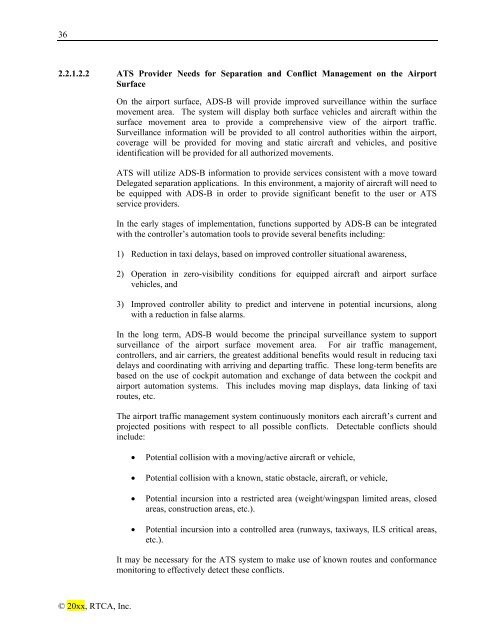Minimum Aviation System Performance Standards for Aircraft ...
Minimum Aviation System Performance Standards for Aircraft ...
Minimum Aviation System Performance Standards for Aircraft ...
Create successful ePaper yourself
Turn your PDF publications into a flip-book with our unique Google optimized e-Paper software.
36<br />
2.2.1.2.2 ATS Provider Needs <strong>for</strong> Separation and Conflict Management on the Airport<br />
Surface<br />
© 20xx, RTCA, Inc.<br />
On the airport surface, ADS-B will provide improved surveillance within the surface<br />
movement area. The system will display both surface vehicles and aircraft within the<br />
surface movement area to provide a comprehensive view of the airport traffic.<br />
Surveillance in<strong>for</strong>mation will be provided to all control authorities within the airport,<br />
coverage will be provided <strong>for</strong> moving and static aircraft and vehicles, and positive<br />
identification will be provided <strong>for</strong> all authorized movements.<br />
ATS will utilize ADS-B in<strong>for</strong>mation to provide services consistent with a move toward<br />
Delegated separation applications. In this environment, a majority of aircraft will need to<br />
be equipped with ADS-B in order to provide significant benefit to the user or ATS<br />
service providers.<br />
In the early stages of implementation, functions supported by ADS-B can be integrated<br />
with the controller’s automation tools to provide several benefits including:<br />
1) Reduction in taxi delays, based on improved controller situational awareness,<br />
2) Operation in zero-visibility conditions <strong>for</strong> equipped aircraft and airport surface<br />
vehicles, and<br />
3) Improved controller ability to predict and intervene in potential incursions, along<br />
with a reduction in false alarms.<br />
In the long term, ADS-B would become the principal surveillance system to support<br />
surveillance of the airport surface movement area. For air traffic management,<br />
controllers, and air carriers, the greatest additional benefits would result in reducing taxi<br />
delays and coordinating with arriving and departing traffic. These long-term benefits are<br />
based on the use of cockpit automation and exchange of data between the cockpit and<br />
airport automation systems. This includes moving map displays, data linking of taxi<br />
routes, etc.<br />
The airport traffic management system continuously monitors each aircraft’s current and<br />
projected positions with respect to all possible conflicts. Detectable conflicts should<br />
include:<br />
� Potential collision with a moving/active aircraft or vehicle,<br />
� Potential collision with a known, static obstacle, aircraft, or vehicle,<br />
� Potential incursion into a restricted area (weight/wingspan limited areas, closed<br />
areas, construction areas, etc.).<br />
� Potential incursion into a controlled area (runways, taxiways, ILS critical areas,<br />
etc.).<br />
It may be necessary <strong>for</strong> the ATS system to make use of known routes and con<strong>for</strong>mance<br />
monitoring to effectively detect these conflicts.

















